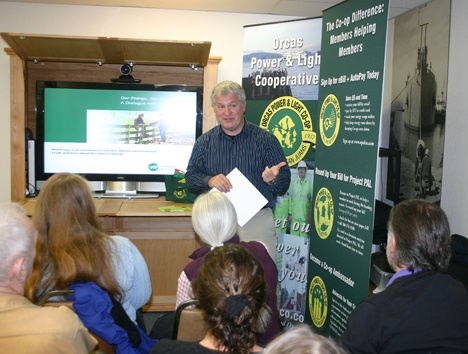As you illuminate your house for the holidays, keep this in mind:
America has maxed out its electricity generating capacity. There will be electricity shortages as soon as 2011 in some parts of America. And it could get worse as we struggle to find new, cleaner ways to generate electricity: America lacks the technology to meet its climate change goal deadlines.
That was the bad news laid out at a series of OPALCO meetings on the islands Nov. 19-20 featuring state Rep. Jeff Morris, D-Anacortes; and Kent Lopez, director of the Washington Rural Electric Cooperative Association.
But there was some good news.
Morris outlined laws that have been adopted to improve energy efficiency and facilitate investment in green technology in the Evergreen State.
Washington was one of the first 10 states to adopt energy efficiency laws on 10 appliances for in-state use that could conserve some 90 megawatt hours of electricity by 2020 – that’s enough electricity to power more than 90,000 homes.
State laws approved since 2005:
— Created minimum efficiency standards and testing procedures for 18 categories of electrical products
— Require the State Building Code Council to adopt energy codes for new homes and buildings that will gradually move toward a 70 percent reduction in energy use for such buildings by 2031.
— Require the state Commerce Department to develop a strategic plan for enhancing energy efficiency and reducing greenhouse gases in homes, buildings and neighborhoods. “In doing so, they must identify barriers to achieving net zero energy use and ways to overcome these barriers in future updates to the State Energy Code,” Morris said.
— Require all investor-owned and consumer-owned electric utilities with more than 25,000 customers to develop detailed integrated resource plans that describe the mix of generating resources and conservation and efficiency resources that will meet current and projected needs of the utility at the lowest reasonable cost.
— Provide that all major facility projects funded in the state capital budget, or projects financed through a financing contract, be designed, constructed and certified to meet the U.S. Green Building Council Leadership in Energy and Environmental Design (LEED) silver standard.
— Make available secured loans to finance all or part of the project costs of any energy efficiency improvement or renewable energy improvement. The period of such loans is 10 years for energy efficiency improvements and 25 years for renewable energy improvements, repaid in the project’s monthly utility bill. The loans will be funded with Sustainable Energy Trust bonds.
Fifteen percent of our energy must be renewable by 2020, Morris said. Expect more wind power to be generated in the Columbia River Gorge; more than 40 wind projects and two substations are proposed. Wind projects generate 2,200 megawatt hours of electricity now (1 megawatt hour is enough to power 1,000 homes for one hour). Additional wind projects could boost that number to 4,000 megawatt hours. Generating electricity from waves and offshore wind could also be employed in the future.
Speaking of renewable energy, as of August some 48 OPALCO members were generating their own electricity, with a total generating capacity of about 185,550 kilowatt hours per year. These renewable projects — mostly solar, but also some wind and micro-hydro — are connected to the grid. OPALCO measures the energy generated and reduces the member’s electricity bill accordingly, essentially buying the electricity from the member.
There are simple things you can do around the house to reduce your energy consumption.
Consider this, courtesy of OPALCO:
— For every degree you lower your thermostat setting, you reduce your heating costs 1 percent. A programmable thermostat can save you up to $100 annually when programmed and used properly.
— High efficiency water heaters use 10 percent less energy.
— Compact fluorescent bulbs use two-thirds less electricity and last 10 times longer than traditional light bulbs and fixtures.
— Low-flow showerheads use less hot water.
— Energy Star-rated appliances will net you energy and budgetary savings – and you may be eligible for incentives and rebates on your purchases.
— Coffee makers, DVD players, electric toothbrushes, microwave ovens and plasma TVs use energy even while not in use. Unplug the device until needed, or connect to a power strip and turn the rocker switch off. It is estimated that this so-called “vampire” electric use costs $3 billion a year, nationwide, according to OPALCO.
— OPALCO conducts free energy audits to help consumers figure out how to make their homes and businesses more energy-efficient. Call 376-3571.




